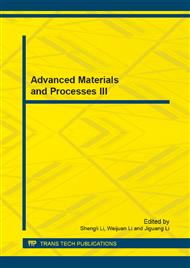p.174
p.179
p.187
p.191
p.196
p.201
p.205
p.209
p.214
Study on the Behavior of Internal Oxidation of Ag-Cu-Zn Alloy
Abstract:
the behavior of internal oxidation of Ag-Cu-Zn alloy was studied at various internal oxidation temperatures for different internal oxidation time. The experimental results show that the short path diffusion, such as boundary diffusion and surface diffusion, is the main diffusion channel of oxygen in initial stage of oxidation, oxidation rate is fast, while the internal oxidation exponent n=1. Then the oxygen diffusion translated from short path diffusion into long path diffusion with the extending of internal oxidation time, and the oxidation rate was slowed down, while the internal oxidation exponent n=1.67. The action size is increased with the temperature increase. The diffusion activation energy of oxygen in initial stage of oxidation is lower than that in middle and late stage.
Info:
Periodical:
Pages:
196-200
Citation:
Online since:
September 2013
Authors:
Price:
Сopyright:
© 2013 Trans Tech Publications Ltd. All Rights Reserved
Share:
Citation:


